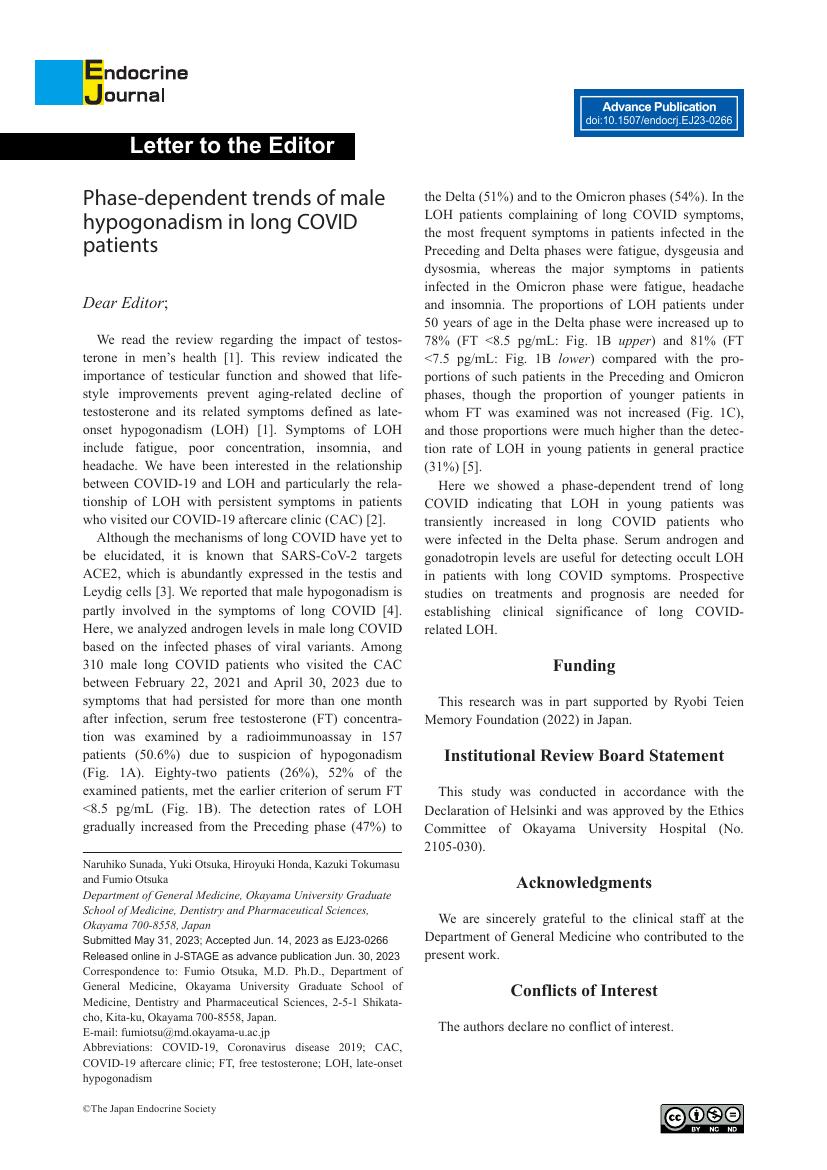- 著者
- Naruhiko Sunada Hiroyuki Honda Yasuhiro Nakano Koichiro Yamamoto Kazuki Tokumasu Yasue Sakurada Yui Matsuda Toru Hasegawa Yuki Otsuka Mikako Obika Yoshihisa Hanayama Hideharu Hagiya Keigo Ueda Hitomi Kataoka Fumio Otsuka
- 出版者
- The Japan Endocrine Society
- 雑誌
- Endocrine Journal (ISSN:09188959)
- 巻号頁・発行日
- pp.EJ22-0093, (Released:2022-04-28)
- 被引用文献数
- 26
Symptoms of long COVID are complex and long-lasting, and endocrine dysfunction might be involved in the underlying mechanisms. In this study, to clarify the hormonal characteristics of long COVID patients, laboratory data for patients who visited the outpatient clinic for long COVID were evaluated. A retrospective analysis was performed for patients who visited Okayama University Hospital during the period from Feb 2021 to Dec 2021 with focus on the interrelationships between major symptoms and endocrine data. Information and laboratory data were obtained from medical records for 186 patients. The patients had various symptoms, and the most frequent symptoms were general malaise, dysosmia/dysgeusia, hair loss, headache, dyspnea, and sleeplessness. Patients who were suffering from fatigue and dysosmia/dysgeusia were younger, while hair loss was more frequent in older and female patients. As for the characteristics of patients suffering from general fatigue, the scores of depression and fatigue were positively correlated with serum levels of cortisol and free thyroxin (FT4), respectively. Also, patients suffering from general fatigue had lower levels of serum growth hormone and higher levels of serum FT4, while patients with dysosmia/dysgeusia had a significantly lower level of serum cortisol. Serum thyrotropin (TSH) levels were higher and the ratios of FT4/TSH were lower in the initially severe cases, suggesting occult hypothyroidism. In addition, the ratios of plasma adrenocorticotropin to serum cortisol were decreased in patients with relatively high titers of serum SARS-CoV-2 antibody. Thus, hormonal changes seem to be, at least in part, involved in the persistent symptoms of long COVID.
- 著者
- Naruhiko Sunada Yuki Otsuka Hiroyuki Honda Kazuki Tokumasu Fumio Otsuka
- 出版者
- The Japan Endocrine Society
- 雑誌
- Endocrine Journal (ISSN:09188959)
- 巻号頁・発行日
- pp.EJ23-0266, (Released:2023-06-30)
- 被引用文献数
- 1
- 著者
- Naruhiko Sunada Hiroyuki Honda Yasuhiro Nakano Koichiro Yamamoto Kazuki Tokumasu Yasue Sakurada Yui Matsuda Toru Hasegawa Yuki Otsuka Mikako Obika Yoshihisa Hanayama Hideharu Hagiya Keigo Ueda Hitomi Kataoka Fumio Otsuka
- 出版者
- The Japan Endocrine Society
- 雑誌
- Endocrine Journal (ISSN:09188959)
- 巻号頁・発行日
- vol.69, no.10, pp.1173-1181, 2022 (Released:2022-10-28)
- 参考文献数
- 34
- 被引用文献数
- 2 26
Symptoms of long COVID are complex and long-lasting, and endocrine dysfunction might be involved in the underlying mechanisms. In this study, to clarify the hormonal characteristics of long COVID patients, laboratory data for patients who visited the outpatient clinic for long COVID were evaluated. A retrospective analysis was performed for patients who visited Okayama University Hospital during the period from Feb 2021 to Dec 2021 with focus on the interrelationships between major symptoms and endocrine data. Information and laboratory data were obtained from medical records for 186 patients. The patients had various symptoms, and the most frequent symptoms were general malaise, dysosmia/dysgeusia, hair loss, headache, dyspnea, and sleeplessness. Patients who were suffering from fatigue and dysosmia/dysgeusia were younger, while hair loss was more frequent in older and female patients. As for the characteristics of patients suffering from general fatigue, the scores of depression and fatigue were positively correlated with serum levels of cortisol and free thyroxin (FT4), respectively. Also, patients suffering from general fatigue had lower levels of serum growth hormone and higher levels of serum FT4, while patients with dysosmia/dysgeusia had a significantly lower level of serum cortisol. Serum thyrotropin (TSH) levels were higher and the ratios of FT4/TSH were lower in the initially severe cases, suggesting occult hypothyroidism. In addition, the ratios of plasma adrenocorticotropin to serum cortisol were decreased in patients with relatively high titers of serum SARS-CoV-2 antibody. Thus, hormonal changes seem to be, at least in part, involved in the persistent symptoms of long COVID.
- 著者
- Yoshito Nishimura Asami Nishikori Haruki Sawada Torrey Czech Yuki Otsuka Midori Filiz Nishimura Hiroki Mizuno Naoki Sawa Shuji Momose Kumiko Ohsawa Fumio Otsuka Yasuharu Sato
- 出版者
- The Japanese Society for Lymphoreticular Tissue Research
- 雑誌
- Journal of Clinical and Experimental Hematopathology (ISSN:13464280)
- 巻号頁・発行日
- pp.21038, (Released:2022-03-05)
- 参考文献数
- 38
- 被引用文献数
- 4
Idiopathic multicentric Castleman disease (iMCD) is a systemic disorder characterized by systemic inflammation and organ dysfunction associated with an increase in pro-inflammatory cytokines. Some patients with iMCD are positive for autoantibodies, although their significance and relationship with specific associated autoimmune diseases are unclear. This study retrospectively analyzed the clinicopathological features of iMCD patients focusing on autoantibodies. Among 63 iMCD patients in our database, 19 were positive for at least one autoantibody. Among the 19, we identified five with plasma cell type (PC)-iMCD lymph node histopathology and positive anti-phospholipid antibodies. These patients were likely to have thrombocytopenia, anasarca, fever, reticulin fibrosis or renal insufficiency, organomegaly (TAFRO) symptoms, and thrombotic events. The present study suggests that patients with undiagnosed or atypical autoimmune diseases, including anti-phospholipid syndrome (APS), were treated for iMCD. APS may present with thrombocytopenia or even multi-organ failure, which overlap with clinical presentations of iMCD. Due to differences in the treatment regimen and follow-up, recognition of the undiagnosed autoimmune disease process in those suspected of iMCD is essential. Our study highlights the importance of complete exclusion of differential diagnoses in patients with iMCD in their diagnostic workup.
